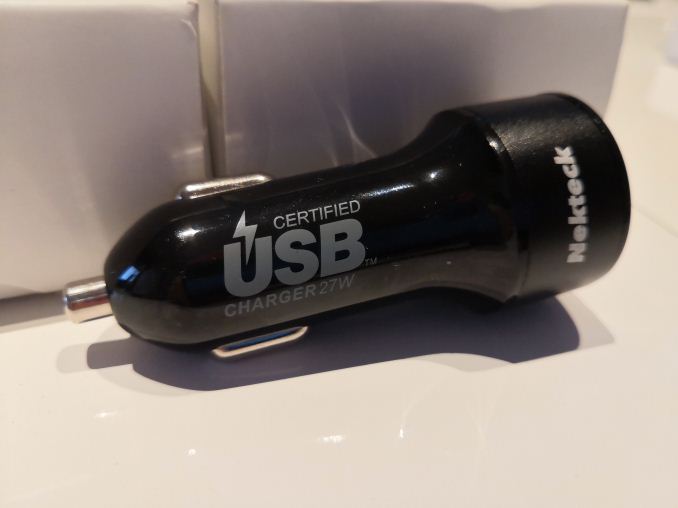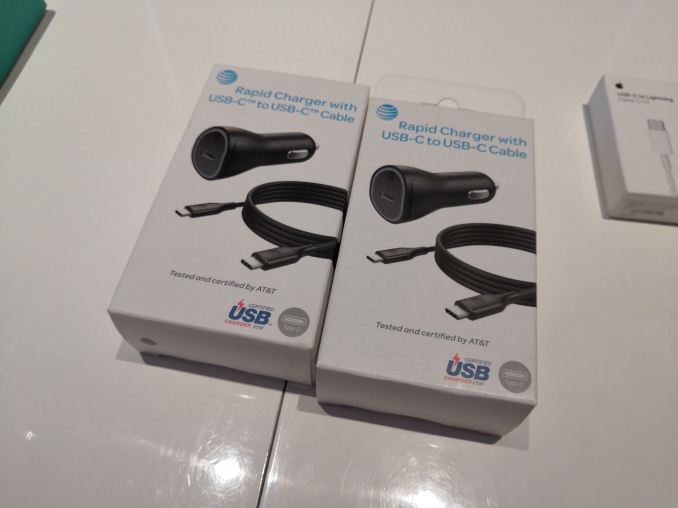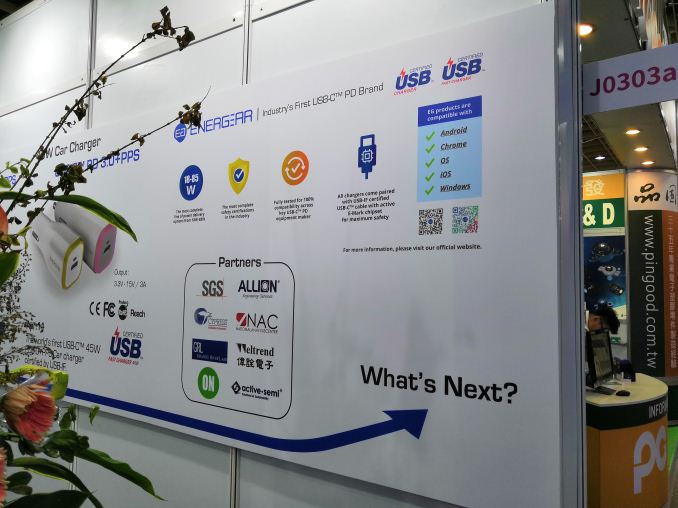USB-IF and Fast Charging: New Standard Logo with Wattage Listed
by Ian Cutress on June 13, 2018 12:00 PM EST- Posted in
- SoCs
- Systems
- charging
- Trade Shows
- USB-IF
- USB
- Computex 2018
- Fast Charging

When discussing industry standards, the sexy ones are involved around performance: if you can breathe PCIe 4.0 or PCIe 5.0 into a sentence, people start listening. One of the standards we actually deal with day in and day out though is around charging and USB charging. Not only do we have a series of standards in play for chargers over USB, but there are also a ton of companies that do their own thing in the mix outside of those standards. It can be, if we’re honest, a bit of a mess.
One of the new ways that the USB-IF is trying to fix this is with certified chargers and fast chargers. The new programs, previously announced in 2016 and back at CES 2018, are finally coming to fruition, and the USB-IF is showing off some of the new products released under the new standards. By using 11 certified test centers worldwide, the newest fast charging standards will enable wall chargers, car chargers, and other dedicated charging devices to carry a logo that states both that the unit adheres to the standards, but also the maximum power.
This listing of power is going to be a good thing. Users can know that if they need a 45W or a 65W charger, that what the logo says on the box is what the unit can handle. At the show we bumped into a company that already has chargers certified to 25W, 27W, 45W, and 65W. It was as clear as day which product was targeted for what sort of application.
Meanwhile the fast charging standard, which implements the USB Power Delivery Programmable Power Supply standard, allows for devices and chargers to do finer-grained voltage negotiation between USB-PD's major power classes (5V, 12V, etc). This allows a device to request the highest voltage it can take, as opposed to having to drop down to a lower power class entirely.
USB-IF also spoke about USB 3.2, with ASMedia at the show having a prototype 2x2 PHY on display. Despite the standard being finalized in September 2017, the first products and controllers are unlikely to be available until 2019 at the earliest.
| Want to keep up to date with all of our Computex 2018 Coverage? | ||||||
 Laptops |
 Hardware |
 Chips |
||||
| Follow AnandTech's breaking news here! | ||||||












28 Comments
View All Comments
Small Bison - Wednesday, June 13, 2018 - link
I'm a little rusty on my USB PD specs, but is it possible for problems such as "device expects low voltage/high amperage charging, but the charger supplies high voltage/low amperage"? For example, a tablet that expects 5V @ 5A connected to a charger that does a max of 20V and 3A, leading to a 60W charger charging your tablet at 15W instead of the expected 25W.Or are the specs such that an official 60W charger will support all official modes possible below 60W?
deil - Wednesday, June 13, 2018 - link
That's perfect question :) 5v and 9v, 12v will make a lot of difference lets say that charger does 3A on all 5V, 9V,12V but info will show only 36W when you might get 15.DanNeely - Wednesday, June 13, 2018 - link
Pretty sure it's the former, or at least the former would be allowed. 5A requires heavier wiring than 3A in the cable, I'd assume the same is true for the leads in the socket; and a PSU that could do 3A @ 5V/9//12V @ 5A but only 3A @ 20V would have a higher BOM than one that could only do 3A at all voltages.Impulses - Thursday, June 14, 2018 - link
IIRC 5A isn't even an option without an e-marked or chipped cable that allows for the proper handshake between charger and device. PD chargers are supposed to be a lot smarter and not just output whatever they want, supposed being the operative word of course... Manufacturers were messing it up aplenty early on (like, a year ago).ZeDestructor - Wednesday, June 13, 2018 - link
If I understood the spec properly (and I really hope I did, cause it was some very simple english there), it should be as follows:Charger rated for 20Vx5A (the absolute max) should be able to do 5Vx3A, 9Vx3A, 15Vx3A and 20x5A.
Charger rated for 20Vx1.5A should be able to do 5Vx3A, 9Vx3A, 15Vx2A and 20x1.5A.
The idea is to keep going up a voltage to 3A then moving up to the next voltage upto the max of 20V, at which point you can finally go up to 5A. This applies to both power supplies/chargers and devices, so your hypothetical scenario shouldn't happen.
In practice, USB-IF, UL, IEC etc have all been so spectacularly bad at enforcing spec that one basically has no idea what could possibly happen.
Valantar - Wednesday, June 13, 2018 - link
That would at least be the only solution that makes sense, as increasing voltage is far safer and more efficient than increasing the amperage. Of course, there are plenty of proprietary "standards" out there, and several of them charge at 5V>3A. The Dash Charge system for my OnePlus is one of those - it's an USB-A charger, so it only outputs 5V, but up to 4A.ZeDestructor - Wednesday, June 13, 2018 - link
Only with the right cables, and generally lower than 5V. Plug a regular cable and it's down to a fixed 5Vx2A.name99 - Wednesday, June 13, 2018 - link
Not to mention that this scenario (and the logo) do not solve the problem of CABLE's being out of spec...You may think this is an unlikely problem but my experience has been that in the world of third party (non-Apple-certified) Lightning cables, they ALL seem to use the absolute thinnest wire they can get away, so that they will charge an iPhone, but using them with an iPad means that after a week or two they burn out and stop working.
(Criticize Apple all you like, but one thing their certification achieves is allowing you to avoid this crap WHEN the product you want is available in certified form. Unfortunately I want multi-headed charging cables [say Lightning, old Apple 30-pin, and micro-US] and there does not seem to be a single manufacturer that sells such cables that are Apple certified --- or I'd settle for the weaker status of just "does not suck".)
ZeDestructor - Wednesday, June 13, 2018 - link
Like I alluded to, it's entirely the fault of USB-IF, UL, IEC, and other regulatory and standards bodies for not raking offenders over the firepit until compliance or death.That said, if you buy your cables from good, reputable vendors like Belkin or Kanex, you'll have a lovely time, including if you want a cool 40G TB3 cable or a 5A cable or such.
Impulses - Thursday, June 14, 2018 - link
It's worth noting that a multi head cable would probably not pass certification anyway... And a fast (top speed) charging cable doesn't need to be super expensive, a cable can be made to handle faster charging speeds yet not the fastest data speeds (those are cheaper, and available in longer runs too). The USB-IF could've made this clearer to users from the start...